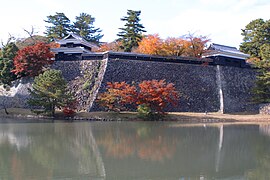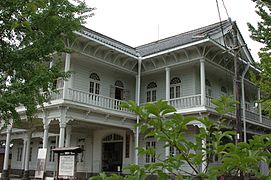Matsue Castle
| Matsue-jō | ||
|---|---|---|
|
The keep of Matsue |
||
| Alternative name (s): | Chidori-jō | |
| Creation time : | 1607-1611 | |
| Conservation status: | Castle tower preserved | |
| Construction: | Stone, wood | |
| Place: | Matsue | |
| Geographical location | 35 ° 28 '30 " N , 133 ° 3' 3" E | |
|
|
||
The Castle Matsue ( Jap. 松江城 , Matsue-jō ) is a Japanese castle in Matsue in Shimane Prefecture . It is also called "Plover Castle" ( 千 鳥 城 , Chidorijō ). Most recently, a branch of the Matsudaira resided there as a great daimyo.
Lords of the castle in the Edo period
- From 1600 the Horio with an income of 240,000 Koku
- from 1634 a branch of Kyōgoku with 264,000 Koku,
- from 1638 a branch of the Matsudaira with 186,000 koku.
history
Horio Yoshiharu ( 堀 尾 吉 晴 ; 1544-1611), who had successfully participated in the Battle of Sekigahara , was appointed Taishu by Tokugawa Ieyasu and rewarded with an income of 240,000 koku. In 1607 he decided to leave the Gassantomida castle ( 月 山 城- , -jō ) located deep in the mountains and a new castle on Lake Shinji ( 宍 道 湖 , -ko ) because of the better management of his fiefdom Mount Kameda ( 亀 田 山 , -jō ) which was completed in 1611. Kyōgoku Tadataka ( 京 極 忠 高 , 1593–1637) followed briefly as lords of the castle, then a Matsudaira branch took over the castle until the Meiji restoration .
The attachment
The mountain Kameda, on which the castle was built, was protected by the river Ōhashi ( 大橋 川 , -gawa ) and by the (at that time adjacent) Shinji Lake. Marshes were protected from east to north. The central castle area, the Hommaru ( 本 丸 ), was laid out at the highest point . The second area, the Ni-no-maru, is divided into two parts: the upper part is located south of the Hommaru, the lower part to the west of it and significantly lower. The Sa-no-maru was created in the south below the upper Ni-no-maru.
Ds Hommaru was well protected by numerous watchtowers. The residence was in San-no-maru, in the somewhat separated castle area. which was connected to the Ni-no-maru by a covered bridge, which was called accordingly "hallway bridge" ( 廊下 橋 , Rōka-bashi ).
The castle tower ( 天 守 閣 , tenshukaku ) of Matsue Castle is one of the twelve castle towers preserved from the Edo period and the only one that is located in the San'in ( 山 陰道 , San'indō ) provincial group on the Japan Sea . On the outside it appears to have four floors, inside there are five. The castle tower consists of a two-story watchtower on which a three-story tower is placed. It is expressly set up for real defense: it has 94 hatch shafts ( 蓋 付 狭 間 , futatsuki zama ) for dropping stones. You enter the castle tower in the south through a porch.
After the Meiji restoration, all buildings except for the castle tower were demolished and the castle grounds became an urban park. In 2001 the south watchtower ( 南 Süd , Minami-yagura ), the middle watchtower ( 中 櫓 , Naka-yagura ) and the drum watchtower were built on the southeast side of Ni-no-maru on the basis of old photos and plans ( 太 鼓 櫓 , Taiko-yagura ) restored. The large main gate ( 大 手 口 , Ōte-guchi ) in box style ( 枡 形式 , masugata-shiki ) and the simpler gate Ichi-no-mon ( 一 の 門 ) as well as a fountain were restored according to documents.
In the southwestern part of the castle is a white wooden two-story building in European style, which was built in 1903 on the occasion of the visit of Emperor Meiji under the name "Pavilion of the breaking clouds" ( 興 雲閣 , Kōun-kaku ). The building is now used as a local museum ( 松枝 郷 土 館 , Matsue kyōdokan ).
photos
Remarks
- ↑ Taishu ( 太守 ) was a title that was created in 826 for the governors of the three provinces of Hitachi , Kazua and Kōzuke . Under Ieyasu the title had only a formal meaning.
literature
- Kato, Masafumi: Matsue-jo in: Miura, Masayuki (Ed.): Shiro to jinya. Saikoku-hen. Gakken, 2006. ISBN 978-4-05-604379-2 .
- Nishigaya, Yasuhiro (Ed.): Matsue-jo. In: Nihon meijo zukan, Rikogaku-sha, 1993. ISBN 4-8445-3017-8 .
- Morton S. Schmorleitz: Castles in Japan . Charles E. Tuttle, Tokyo 1974, ISBN 0-8048-1102-4
- Hinago Motoo: Japanese Castles . Kodansha, Tokyo 1986, ISBN 0-87011-766-1







